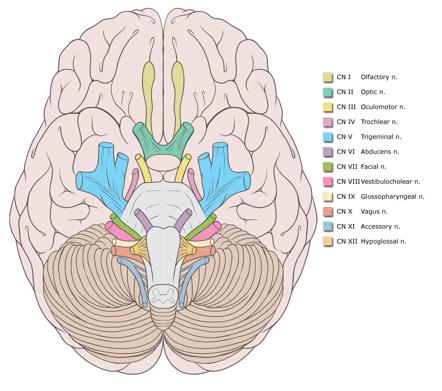Cranial Nerves: Difference between revisions
(added video) |
(edit video link) |
||
| Line 87: | Line 87: | ||
<br> | <br> | ||
{{#ev:youtube| | {{#ev:youtube|FtJtYMRVw7A}} | ||
<br> | |||
== Clinical relevance == | == Clinical relevance == | ||
Revision as of 03:12, 5 October 2016
Original Editor - Tarina van der Stockt
Top Contributors - Tarina van der Stockt, Lucinda hampton, Innocent Abugu, Kim Jackson, Evan Thomas, Donald John Auson, Areeba Raja, Wendy Walker, Ahmed M Diab, 127.0.0.1, Daniele Barilla, WikiSysop and Kehinde Fatola
Description
[edit | edit source]
There are 12 pairs of cranial nerves and they are numbered according to their position of where they originate on the inferior surface of the brain. The names of the cranial nerves (CN) are: CN I - olfactory, CN II - optic, CN III - oculomotor, CN IV - trochlear, CN V - trigeminal, CN VI - abducens, CN VII - facial, CN VIII - vestibulocochlear, CN IX - glossopharyngeal, CN X - vagus, CN XI - accessory, and CN XII - hypoglossal. [1]
Function[edit | edit source]
The names of the cranial nerves sometimes correspond with their individual function. The cranial nerves are comprised of axons that are either sensory, motor or both. [1]
| Cranial Nerve | Sensory Function | Somatic Motor Function | Autonomic (parasympathetic motor) Function |
|---|---|---|---|
| CN I - olfactory |
Smell (olfaction) |
- |
- |
| CN II - optic |
Vision |
- |
- |
| CN III - oculomotor |
- |
Innervates the inferior oblique muscle and medial, inferior, and superior rectus muscles of the eye (move the eye); levator palpebrae superioris muscle (elevate eyelid) |
Innervates the sphincter pupillae muscle (constricts the pupil), and the ciliary muscle (accomodate the eye for near vision) |
| CN IV - trochlear |
- |
Innervate the superior oblique eye muscle (moves the eye inferiorly and laterally) |
- |
| CN V - trigeminal |
Conducts touch, temperature and pain sensation from the face, nose, mouth, nasal and oral mucosa, anterior two-thirds of tongue, and anterior scalp; part of auricle of the ear |
Innervate the muscles of mastication, mylohyoid, digastric (anterior belly), tensor veli palatini, and tensor tympani |
- |
| CN VI - abducens |
- |
Innervate the lateral rectus muscle of eye (abducts the eye) |
- |
| CN VII - facial |
Taste from anterior two-thirds of tongue |
Innervate muscles of facial expression, digastric (posterior belly) and stapedius muscle |
Increase secretion from the lacrimal (tear glands) and nasal mucosal glands; submandibular and sublingual salivary glands |
| CN VIII - vestibulocochlear |
Hearing (cochlear branch); linear and angular acceleration, or head position in space/equilibrium (vestibular branch) |
- |
- |
| CN IX - glossopharyngeal |
Touch and taste from the posterior 1/3 of the tongue; visceral sensory from the carotid bodies |
Innervate the pharyngeal muscle |
Increase secretion from the parotid salivary gland |
| CN X - vagus |
Visceral sensation (excluding pain) from heart, lungs, abdominal organs, bronchi, trachea, larynx, pharynx, gastrointestinal tract to level of descending colon General sensation from the external acoustic meatus, eardrum, and pharynx |
Innervates pharyngeal and laryngeal muscles and muscles at base of tongue |
Innervates smooth muscle an glands of the heart, lungs larynz trachea, and most abdominal organs |
| CN XI - accessory |
- |
Innervates the trapezius and sternocleidomastoid muscle |
- |
| CN XII - hypoglossal |
- |
Innervates intrinsic and extrinsic tongue muscles |
- |







